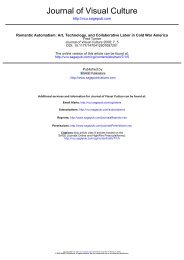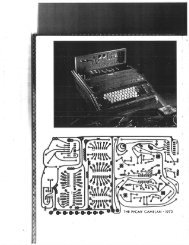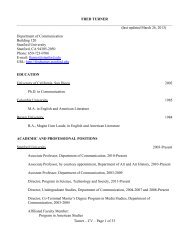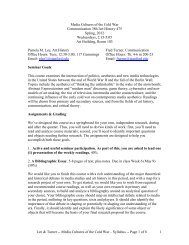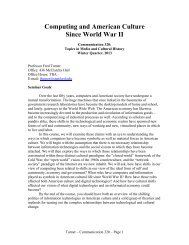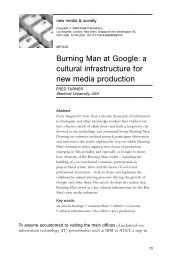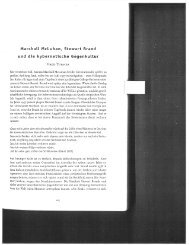The Family of Man and the Politics of Attention in ... - Public Culture
The Family of Man and the Politics of Attention in ... - Public Culture
The Family of Man and the Politics of Attention in ... - Public Culture
Create successful ePaper yourself
Turn your PDF publications into a flip-book with our unique Google optimized e-Paper software.
<strong>Public</strong> <strong>Culture</strong><br />
tended to be built around authoritarian <strong>in</strong>dividuals; democratic countries tended<br />
to be built around a more open, more tolerant, more rational alternative. In both<br />
cases, susta<strong>in</strong><strong>in</strong>g a particular form <strong>of</strong> government required promot<strong>in</strong>g a particular<br />
state <strong>of</strong> m<strong>in</strong>d. To that end, Steichen <strong>and</strong> his colleagues hoped to f<strong>in</strong>d a way to<br />
help Americans embrace <strong>the</strong>ir differences <strong>and</strong> to make <strong>the</strong>m <strong>the</strong> basis <strong>of</strong> national<br />
unity. <strong>The</strong> <strong>Family</strong> <strong>of</strong> <strong>Man</strong> thus became less a vehicle for a s<strong>in</strong>gle message than a<br />
three- dimensional arena <strong>in</strong> which visitors could practice acts <strong>of</strong> mutual recognition,<br />
choice, <strong>and</strong> empathy — <strong>the</strong> core perceptual <strong>and</strong> affective skills on which<br />
democracy depended.<br />
From a half century away, however, we can also recognize <strong>the</strong> exhibition as a<br />
fulcrum moment <strong>in</strong> <strong>the</strong> development <strong>of</strong> an <strong>in</strong>creas<strong>in</strong>gly ubiquitous mode <strong>of</strong> media<br />
power. Even as Steichen gave Americans what he <strong>and</strong> <strong>the</strong>y saw as a democratic<br />
degree <strong>of</strong> freedom <strong>in</strong> relation to imagery <strong>and</strong> so to one ano<strong>the</strong>r, he asked <strong>the</strong>m<br />
to pursue <strong>the</strong>ir <strong>in</strong>dividual experiences with<strong>in</strong> collective terms set by his own aes<strong>the</strong>tic<br />
expertise. Though visitors moved at <strong>the</strong>ir own pace through <strong>the</strong> galleries,<br />
though <strong>the</strong>y could enjoy an enormous variety <strong>of</strong> visual opportunities for pleasure<br />
<strong>and</strong> engagement with o<strong>the</strong>rs both like <strong>and</strong> unlike <strong>the</strong>mselves, <strong>the</strong>y also made <strong>the</strong>ir<br />
choices <strong>in</strong> terms that had been set for <strong>the</strong>m, long before <strong>the</strong>y entered <strong>the</strong> room. In<br />
o<strong>the</strong>r words, even as it freed Americans from <strong>the</strong> massify<strong>in</strong>g effects <strong>of</strong> totalitarianism<br />
<strong>and</strong> its media, <strong>The</strong> <strong>Family</strong> <strong>of</strong> <strong>Man</strong> <strong>in</strong>vited <strong>the</strong>m to adjust <strong>the</strong>mselves to a<br />
s<strong>of</strong>ter but equally pervasive system <strong>of</strong> management.<br />
Such <strong>in</strong>vitations to construct identities <strong>in</strong> terms set by <strong>the</strong> media around us<br />
have become commonplace today. And <strong>the</strong>y po<strong>in</strong>t to a paradox: even as <strong>The</strong> <strong>Family</strong><br />
<strong>of</strong> <strong>Man</strong> championed a far more open, tolerant, <strong>and</strong> diverse society than we<br />
remember, it also helped deliver us <strong>in</strong>to a world <strong>in</strong> which media constantly ask us<br />
to manage ourselves <strong>in</strong> terms set by faraway o<strong>the</strong>rs.<br />
Mak<strong>in</strong>g <strong>The</strong> <strong>Family</strong> <strong>of</strong> <strong>Man</strong>: <strong>The</strong> Official History<br />
Before we can explore <strong>the</strong> exhibition’s role as a precursor to contemporary media<br />
forms, we need to revisit <strong>the</strong> now- canonical story <strong>of</strong> its creation. As told by <strong>the</strong><br />
never- modest Steichen <strong>and</strong> <strong>the</strong> many journalists <strong>and</strong> historians who have followed<br />
his lead, <strong>The</strong> <strong>Family</strong> <strong>of</strong> <strong>Man</strong> emerged primarily out <strong>of</strong> Steichen’s own heroic<br />
impulses. One <strong>of</strong> <strong>the</strong> best- known American photographers <strong>of</strong> <strong>the</strong> early twentieth<br />
century, a chronicler <strong>of</strong> America’s artistic <strong>and</strong> corporate elites, <strong>and</strong>, from 1947<br />
to 1962, <strong>the</strong> director <strong>of</strong> <strong>the</strong> Museum <strong>of</strong> Modern Art’s Photography Department,<br />
Steichen was <strong>in</strong> his midseventies when he started work<strong>in</strong>g on <strong>The</strong> <strong>Family</strong> <strong>of</strong><br />
58



